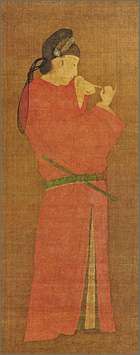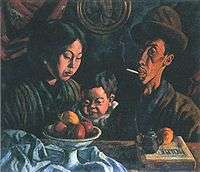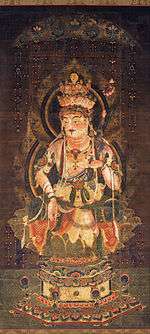List of Cultural Properties of Japan - paintings (Okayama)
This list is of the Cultural Properties of Japan designated in the category of paintings (絵画 kaiga) for the Prefecture of Okayama.[1]
National Cultural Properties
As of 1 August 2015, twenty-nine Important Cultural Properties (including two *National Treasures) have been designated, being of national significance.[2][3][4]
| Property | Date | Municipality | Ownership | Comments | Image | Dimensions | Coordinates | Ref. |
|---|---|---|---|---|---|---|---|---|
| *Court Lady, colour on silk 絹本著色宮女図〈/伝桓野王図〉 kenpon chakushoku kyūjo zu (den-Kanya ō zu) | Yuan dynasty | Kurashiki | private | wearing a red gown and diaphanous black headdress, and with a flute tucked in her girdle; sometimes identified as the Eastern Jin Prince Huan Ye, known for his flute playing, based on a paper slip on a copy of the painting by Kanō Seisen'in Osanobu (狩野養信) in Tokyo National Museum; however labels by Kanō Tan'yū and Kanō Yasunobu (狩野安信) and a document by Osanobu identify the subject as a court lady; the authenticity of the imprint "seal of Qian Xuan" (錢選之印) is uncertain[5] |  | 86.1 centimetres (33.9 in) by 29.9 centimetres (11.8 in) | ||
| *Landscape, ink and light colour on paper, by Sesshū 紙本墨画淡彩山水図〈雪舟筆/〉 shihon bokuga tansai sansui zu (Sesshū hitsu) | Muromachi period | Kurashiki | private | .jpg) | 118.0 centimetres (46.5 in) by 35.5 centimetres (14.0 in) | |||
| N Family, oil on hemp cloth, by Koide Narashige Nの家族(小出楢重筆 一九一九/油絵 麻布) enu no kazoku (Koide Narashige hitsu 1919 abura-e mafu) | 1919 | Kurashiki | Ohara Museum of Art |  | 79.0 centimetres (31.1 in) by 91.0 centimetres (35.8 in) | 34°35′46″N 133°46′14″E / 34.5961746°N 133.77062178°E | ||
| Aizen Myōō, colour on silk 絹本著色愛染明王像 kenpon chakushoku Aizen Myōō zō | Nanboku-chō period | Okayama | Hōtaku-ji (捧沢寺) (kept at Okayama Prefectural Museum) | 1.jpg) | 109.4 centimetres (43.1 in) by 41.0 centimetres (16.1 in) | 34°40′06″N 133°56′02″E / 34.668209°N 133.933863°E | ||
| Aizen Myōō, colour on silk 絹本著色愛染明王像 kenpon chakushoku Aizen Myōō zō | Nanboku-chō period | Okayama | Hōtaku-ji (捧沢寺) (kept at Okayama Prefectural Museum) | 2.jpg) | 88 centimetres (35 in) by 40 centimetres (16 in) | 34°40′06″N 133°56′02″E / 34.668209°N 133.933863°E | ||
| Ukita Yoshie, colour on silk 絹本著色宇喜多能家像 kenpon chakushoku Ukita Yoshie zō | 1524 | Okayama | Okayama Prefectural Museum | .jpeg) | 34°40′06″N 133°56′02″E / 34.668209°N 133.933863°E | |||
| Shaka Triad, colour on silk 絹本著色釈迦三尊像 kenpon chakushoku Shakan sanzon zō | Kamakura period | Nara | Raikyū-ji (kept at Nara National Museum) | .jpg) | 34°41′01″N 135°50′11″E / 34.6837°N 135.8364°E | |||
| Ten Kings of Hell, colour on silk 絹本著色十王像 kenpon chakushoku jūō zu | Yuan dynasty | Okayama | Hōfuku-ji (宝福寺) (kept at Okayama Prefectural Museum) | ten scrolls | _01.jpg) _02.jpg) _03.jpg) _04.jpg) _05.jpg) _06.jpg) _07.jpg) _08.jpg) _09.jpg) _10.jpg) | 98.8 centimetres (38.9 in) by 41.5 centimetres (16.3 in) | 34°40′06″N 133°56′02″E / 34.668209°N 133.933863°E | |
| Twelve Deities, colour on silk, attributed to Zōun 絹本著色十二天像〈(伝増吽筆)/〉 kenpon chakushoku jūniten zō (den-Zōun hitsu) | Kamakura period | Mimasaka | Chōfuku-ji (長福寺) | twelve scrolls | 1.jpg) 2.jpg) | 34°55′36″N 134°09′02″E / 34.926655°N 134.150491°E | ||
| Along the River During the Qingming Festival, colour on silk 絹本著色清明上河図〈趙浙筆/萬暦五年十月の年記がある〉 kenpon chakushoku seimei jōga zu | Ming dynasty | Okayama | Hayashibara Museum of Art | one emakimono | .gif) | 28.7 centimetres (11.3 in) by 576 centimetres (18.90 ft) | 34°39′49″N 133°56′00″E / 34.66358372°N 133.93324308°E | |
| Jizō with the Ten Kings of Hell, colour on silk 絹本著色地蔵十王像 kenpon chakushoku Jizō jūō zu | late Goryeo | Kasaoka | Nikkō-ji (日光寺) | Goryeo Buddhist painting | .jpg) | 117.1 centimetres (46.1 in) by 59.2 centimetres (23.3 in) | 34°27′08″N 133°30′41″E / 34.452170°N 133.511310°E | |
| Jizō Bosatsu, colour on silk 絹本著色地蔵菩薩像 kenpon chakushoku Jizō Bosatsu zō | Yuan dynasty | Okayama | Hōfuku-ji (宝福寺) (kept at Okayama Prefectural Museum) | .jpg) | 111.0 centimetres (43.7 in) by 58.5 centimetres (23.0 in) | 34°40′06″N 133°56′02″E / 34.668209°N 133.933863°E | ||
| Jizō Bosatsu, colour on silk 絹本著色地蔵菩薩像 kenpon chakushoku Jizō Bosatsu zō | Nanboku-chō period | Okayama | Hōtaku-ji (捧沢寺) (kept at Okayama Prefectural Museum) | .jpg) | 91.6 centimetres (36.1 in) by 36.2 centimetres (14.3 in) | 34°40′06″N 133°56′02″E / 34.668209°N 133.933863°E | ||
| Fudō with Three Attendants flanked by the Mandala of the Two Realms, colour on silk 絹本著色中不動三十六童子左右両界曼荼羅図 kenpon chakushoku Fudō sanjūroku dōji sayū ryōkai mandara zu | Nanboku-chō period | Okayama | Hōkō-ji (宝光寺) (kept at Okayama Prefectural Museum) | three scrolls | 3.jpg) 1.jpg) 2.jpg) | 34°40′06″N 133°56′02″E / 34.668209°N 133.933863°E | ||
| Fudō Myōō, colour on silk 絹本著色不動明王像 kenpon chakushoku Fudō Myōō zō | Kamakura period | Okayama | Chōfuku-ji (長福寺) (kept at Okayama Prefectural Museum) | .jpg) | 34°40′06″N 133°56′02″E / 34.668209°N 133.933863°E | |||
| Nirvana painting, colour on silk 絹本著色仏涅槃図 kenpon chakushoku Butsu nehan zu | Kamakura period | Okayama | Anyō-in (安養院) (kept at Okayama Prefectural Museum) | .jpg) | 34°40′06″N 133°56′02″E / 34.668209°N 133.933863°E | |||
| Nirvana painting, colour on silk 絹本著色仏涅槃図 kenpon chakushoku Butsu nehan zu | Kamakura period | Kyoto | Henmyō-in (遍明院) (kept at Kyoto National Museum) | .jpg) | 34°59′24″N 135°46′23″E / 34.99°N 135.773°E | |||
| Descent of Amida with Twenty-Five Bodhisattvas, colour on silk 絹本著色弥陀二十五菩薩来迎図 kenpon chakushoku Mida nijūgo bosatsu raigō zu | Kamakura period | Okayama | Henmyō-in (遍明院) (kept at Okayama Prefectural Museum) | .jpg) | 34°40′06″N 133°56′02″E / 34.668209°N 133.933863°E | |||
| Mandala of the Two Realms, colour on silk 絹本著色弥陀二十五菩薩来迎図 kenpon chakushoku ryōkai mandara zu | Nanboku-chō period | Mimasaka | Chōfuku-ji (長福寺) | 1.jpg) 2.jpg) | 34°55′33″N 134°09′00″E / 34.925877°N 134.150105°E | |||
| Mount Lu, ink on silk, by Yujian 絹本墨画廬山図〈玉澗筆/自賛がある〉 kenpon bokuga rosan zu (Gyokkan hitsu) | Southern Song | Okayama | Okayama Prefectural Museum of Art | .jpeg) | 34°40′04″N 133°55′47″E / 34.66764736°N 133.92979593°E | |||
| Scenes in and around the Capital, colour on paper with gold ground, six-panel byōbu 紙本金地著色洛中洛外図〈/六曲屏風〉 shihon kinji chakushoku rakuchū rakugai zu (rokkyoku byōbu) | Edo period | Okayama | Hayashibara Museum of Art | pair of screens | 1.jpg) 2.jpg) | 159.1 centimetres (62.6 in) by 362.9 centimetres (142.9 in) | 34°39′49″N 133°56′00″E / 34.66358372°N 133.93324308°E | |
| Mountains clad in rain, light colour on paper, by Uragami Gyokudō 紙本淡彩山雨染衣図〈浦上玉堂筆/〉 shihon tansai sanu seni zu (Uragami Gyokudō hitsu) | Edo period | Kurashiki | private | .jpg) | ||||
| Flowers and Birds, colour on paper, by Hasegawa Tōhaku, six-panel byōbu 紙本著色花鳥図〈長谷川信春筆/六曲屏風〉 shihon chakushoku kachō zu (rokkyoku byōbu) | Momoyama period | Okayama | Myōkaku-ji (妙覚寺) (kept at Okayama Prefectural Museum) | pair of screens |  | 149.5 centimetres (58.9 in) by 360 centimetres (140 in) | 34°40′06″N 133°56′02″E / 34.668209°N 133.933863°E | |
| Illustrated Sutra of Cause and Effect, colour on paper 紙本著色絵過去現在因果経〈残闕/〉 shihon chakushoku e-kako genzai inga-kyō | Nara period | Kurashiki | Ohara Museum of Art |  | 34°35′46″N 133°46′14″E / 34.5961746°N 133.77062178°E | |||
| Morning View of the Uji River, colour on paper, by Aoki Mokubei 紙本著色兎道朝暾図〈青木木米筆/〉 shihon chakushoku Uji chōton zu (Aoki Mokubei hitsu) | Edo period | Kurashiki | ||||||
| Landscape, ink on paper, by Sesshū 紙本墨画山水図〈雪舟筆/(仿玉澗)〉 shihon bokuga sansui zu (Sesshū hitsu) | Muromachi period | Okayama | Okayama Prefectural Museum of Art | .jpeg) | 30.3 centimetres (11.9 in) by 31.5 centimetres (12.4 in) | 34°40′04″N 133°55′47″E / 34.66764736°N 133.92979593°E | ||
| Dragon, colour on paper, by Aoki Mokubei 紙本墨画騰竜図〈青木木米筆/癸未(文政六年)の款記がある〉 shihon chakushoku tōryū zu (Aoki Mokubei hitsu) | Edo period | Kurashiki | ||||||
| Sorrow of Faith, oil on hemp cloth, by Sekine Shōji 信仰の悲しみ(関根正二筆 一九一八年/油絵 麻布) shinkō no kanashimi (Sekine Shōji hitsu 1918 abura-e mafu) | 1918 | Kurashiki | Ohara Museum of Art | | 73.0 centimetres (28.7 in) by 100.0 centimetres (39.4 in) | 34°35′46″N 133°46′14″E / 34.5961746°N 133.77062178°E | ||
| Laozi, ink on paper 紙本墨画老子像 牧𧮾筆 shihon bokuga Roshi zu | Okayama | Okayama Prefectural Museum of Art | 34°40′04″N 133°55′47″E / 34.66764736°N 133.92979593°E | |||||
Prefectural Cultural Properties
As of 1 May 2014, twenty-five properties have been designated at a prefectural level.[4][6]
| Property | Date | Municipality | Ownership | Comments | Image | Dimensions | Coordinates | Ref. |
|---|---|---|---|---|---|---|---|---|
| Thirteen Buddhas, colour on silk 絹本著色十三仏図 kenpon chakushoku jūsan Butsu zu | Nanboku-chō period | Okayama | Okayama Prefectural Museum | .jpg) | 95.3 centimetres (37.5 in) by 38.1 centimetres (15.0 in) | 34°40′06″N 133°56′02″E / 34.668209°N 133.933863°E | ||
| Portrait of the Temple Founder, colour on silk 絹本著色開山別峰国師頂相 kenpon chakushoku kaizan beppō kokushi chinzō | Muromachi period | Okayama | Shōrin-ji (松林寺) | .jpg) | 94.5 centimetres (37.2 in) by 56.5 centimetres (22.2 in) | 34°38′42″N 133°51′03″E / 34.644990°N 133.850741°E | ||
| Saidai-ji Engi, colour on paper 紙本著色金陵山古本縁起(西大寺縁起) [二帖 附一帖] shihon chakushoku Kinryōzan furuhon engi (Saidaiji engi) | 1507 | Okayama | Saidai-ji (西大寺) (kept at Okayama Prefectural Museum) | two scrolls, with supplementary designation of a scroll dating from after 1661 | .png) | 34°40′06″N 133°56′02″E / 34.668209°N 133.933863°E | ||
| Map of the World, light colour on paper, six-panel byōbu 紙本淡彩世界図屏風[六曲一双] shihon tansai sekai zu byōbu (rokkyoku issō) | early Edo period | Okayama | Myōkaku-ji (妙覚寺) (kept at Okayama Prefectural Museum) | pair of screens | 97 centimetres (38 in) by 270 centimetres (110 in) | 34°40′06″N 133°56′02″E / 34.668209°N 133.933863°E | ||
| Along the River During the Qingming Festival, ink on paper, emaki 紙本墨画清明上河図巻 shihon bokuga seimei jōga zu maki | late Edo period | Okayama | Myōkaku-ji (妙覚寺) (kept at Okayama Prefectural Museum) | 30.3 centimetres (11.9 in) by 571.2 centimetres (18.74 ft) | 34°40′06″N 133°56′02″E / 34.668209°N 133.933863°E | |||
| Chrysanthemum Boy, six-panel byōbu 菊慈童図屏風[六曲一雙] kiku jidō zu byōbu | early Edo period | Kurashiki | Rendai-ji (蓮台寺) | pair of screens | .jpg) | 152.6 centimetres (60.1 in) by 351 centimetres (138 in) | 34°30′20″N 133°51′02″E / 34.505544°N 133.850512°E | |
| Western-style Ema from Wakamiya Hachimangū 若宮八幡宮欧風絵馬 Wakamiya Hachimangū ōfū ema | 1792 | Okayama | Wakamiya Hachimangū (若宮八幡宮) (kept at Okayama Prefectural Museum) | depicts Gan Jiang and Mo Ye, with western perspective; the inscription 暁嶽国綱 to the left is a nom de plume of Akita ranga artist Tashiro Tadakuni | .jpg) | 109.5 centimetres (43.1 in) by 198.5 centimetres (78.1 in) | 34°40′06″N 133°56′02″E / 34.668209°N 133.933863°E | |
| Shaka Triad, colour on silk 絹本著色釈迦三尊像 kenpon chakushoku Shakan sanzon zō | Nanboku-chō period | Okayama | Jōmyō-ji (浄明寺) (kept at Okayama Prefectural Museum) | .jpg) | 108 centimetres (43 in) by 64 centimetres (25 in) | 34°40′06″N 133°56′02″E / 34.668209°N 133.933863°E | ||
See also
- Cultural Properties of Japan
- List of National Treasures of Japan (paintings)
- Japanese painting
- List of Historic Sites of Japan (Okayama)
References
- ↑ "Pamphlet on Cultural Properties". Agency for Cultural Affairs. Retrieved 16 August 2015.
- ↑ 国宝・重要文化財 [Number of National Treasures and Important Cultural Properties by Prefecture] (in Japanese). Agency for Cultural Affairs. 1 August 2015. Retrieved 16 August 2015.
- ↑ 国宝・重要文化財(美術品)(絵画 岡山県) [Database of National Cultural Properties] (in Japanese). Agency for Cultural Affairs. Retrieved 16 August 2015.
- 1 2 岡山県内指定文化財等件数一覧 [Number of Cultural Properties in Okayama Prefecture]. Okayama Prefecture. 4 March 2014. Retrieved 16 August 2015.
- ↑ 国宝 [National Treasures of Japan] (in Japanese and English). 5. The Mainichi Newspapers. 1966. p. 54.
- ↑ 都道府県別指定等文化財件数(都道府県分) [Number of Prefectural Cultural Properties by Prefecture] (in Japanese). Agency for Cultural Affairs. 1 May 2014. Retrieved 16 August 2015.
External links
- (Japanese) Cultural Properties in Okayama Prefecture
This article is issued from Wikipedia - version of the 4/28/2016. The text is available under the Creative Commons Attribution/Share Alike but additional terms may apply for the media files.
